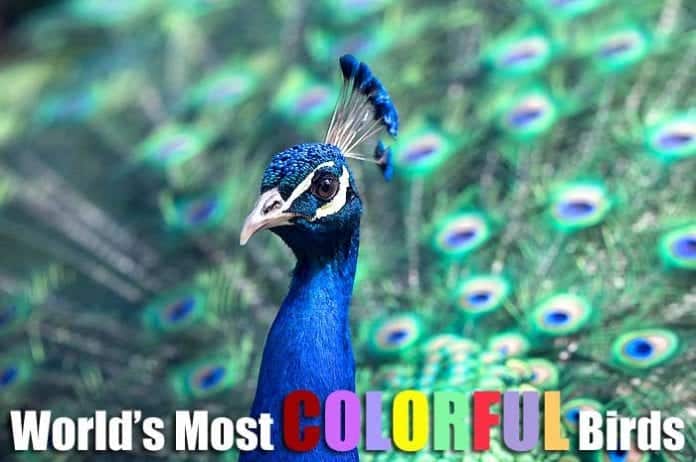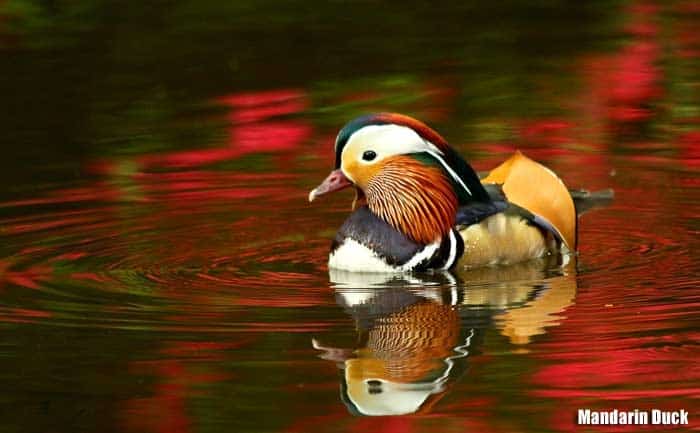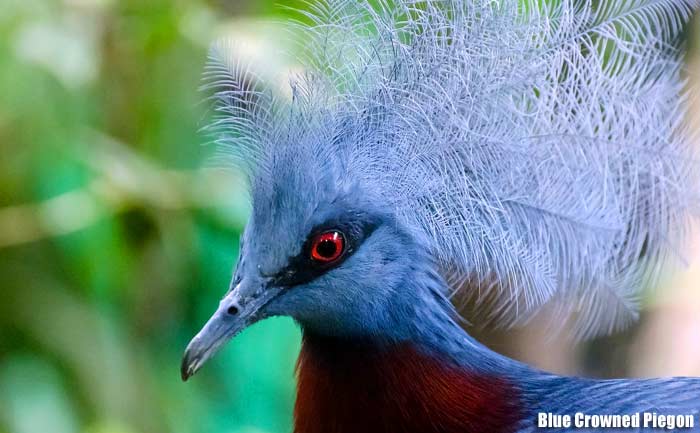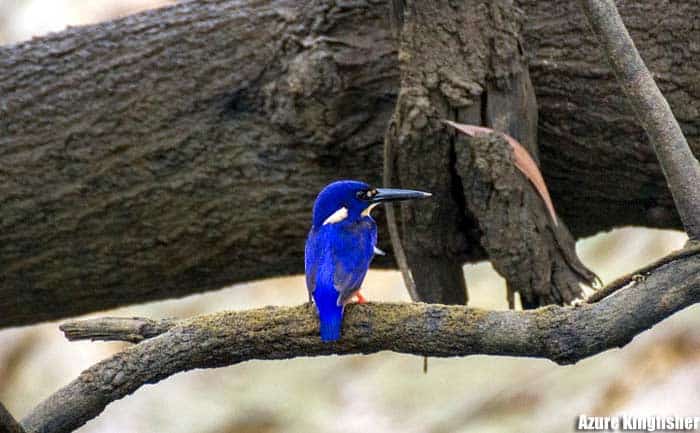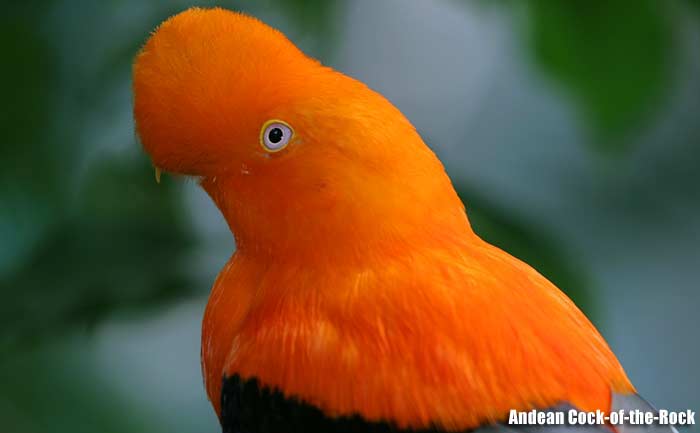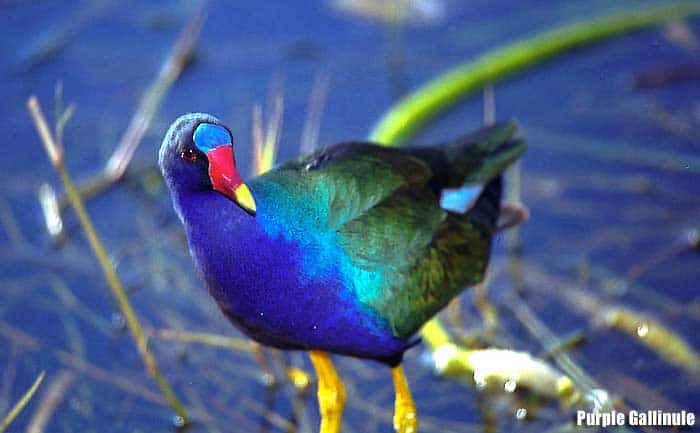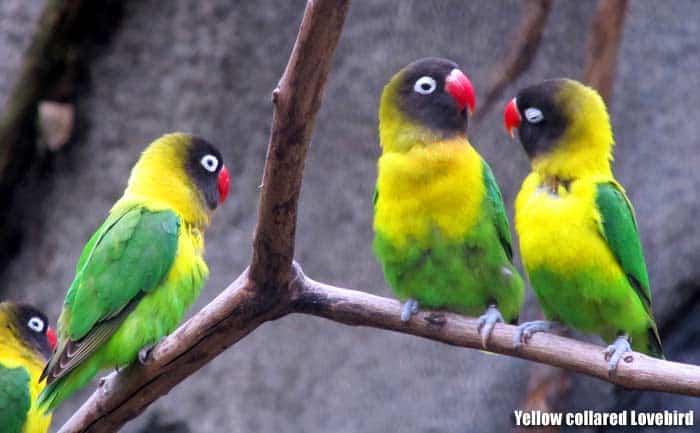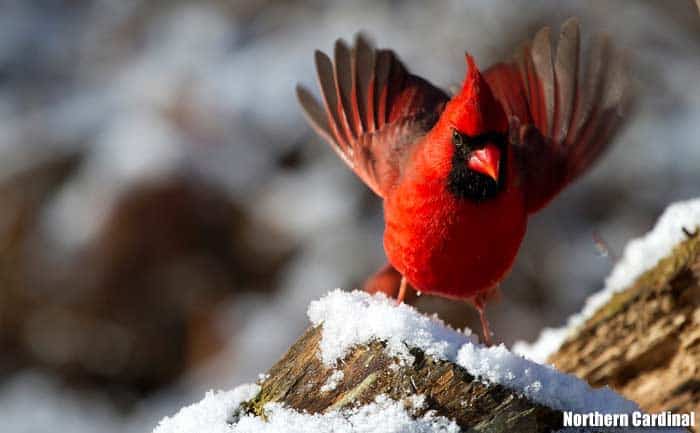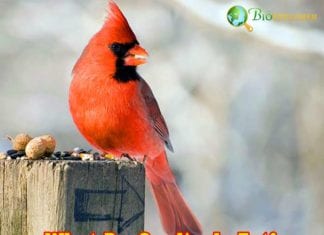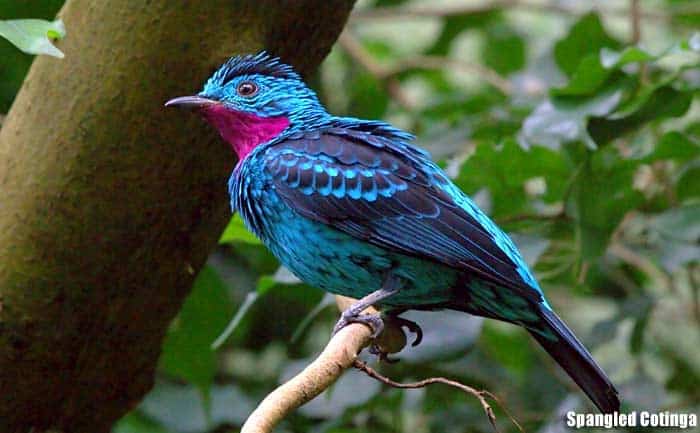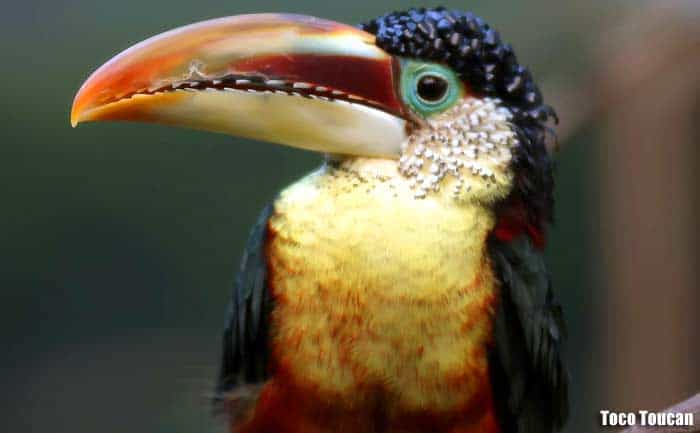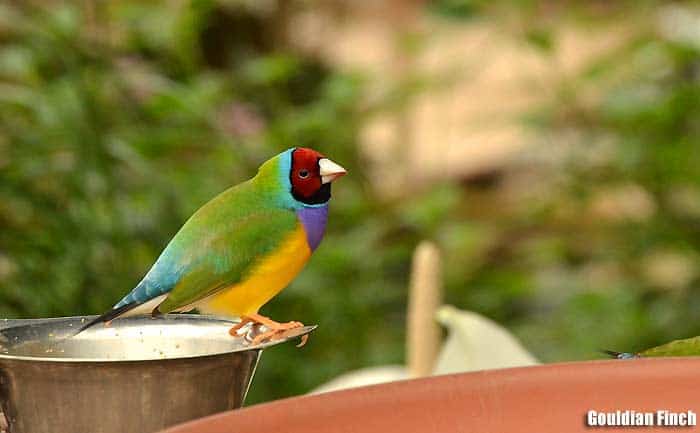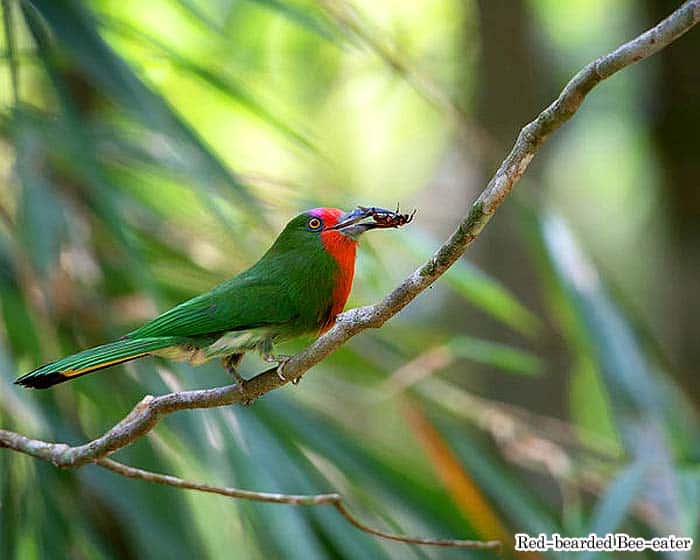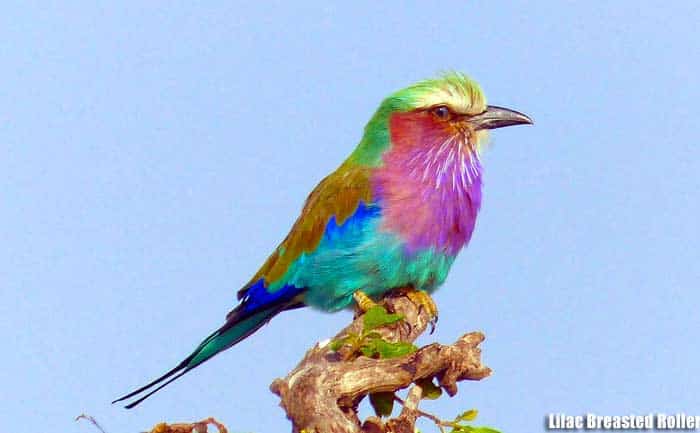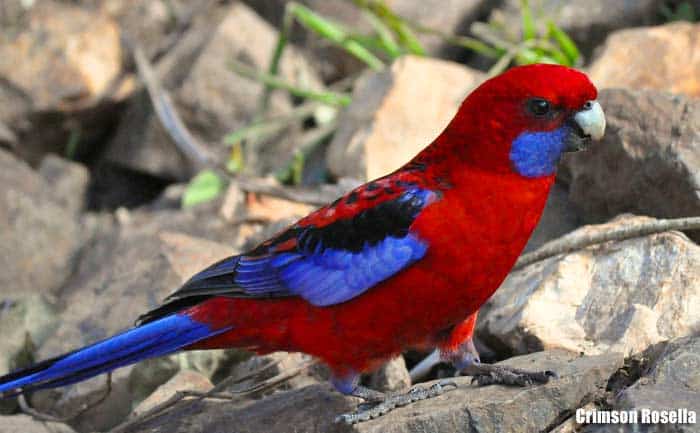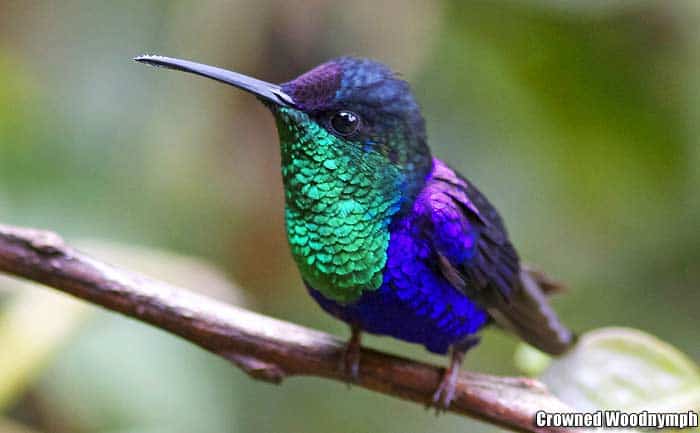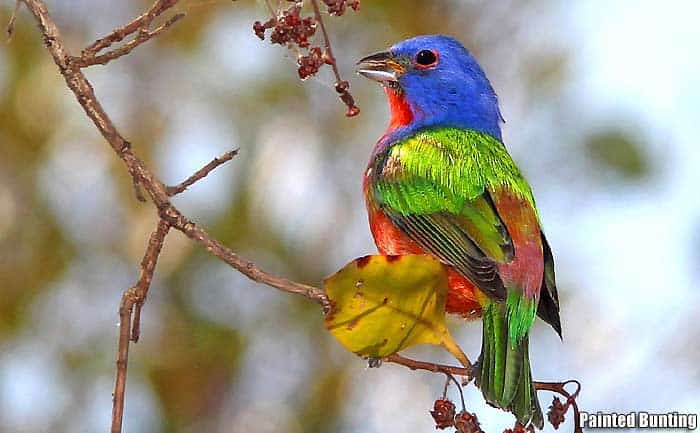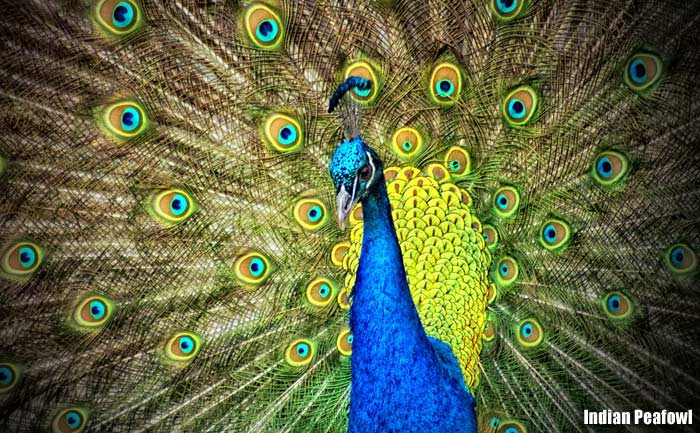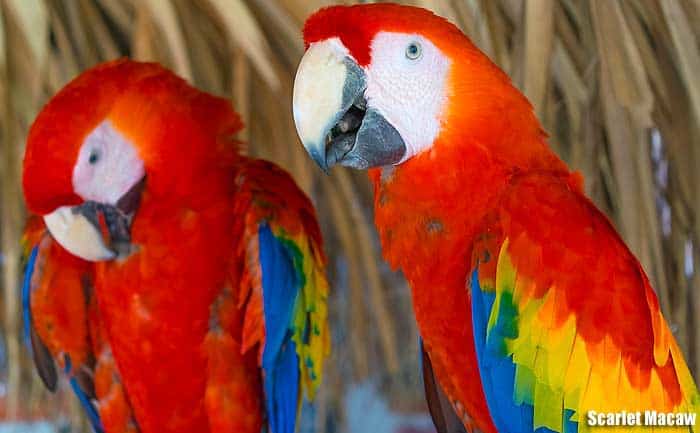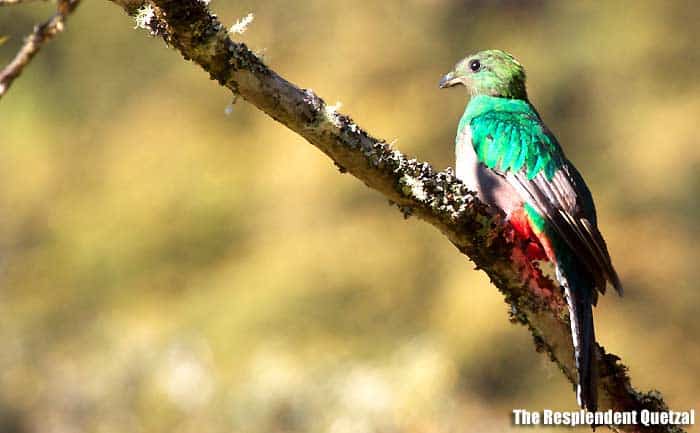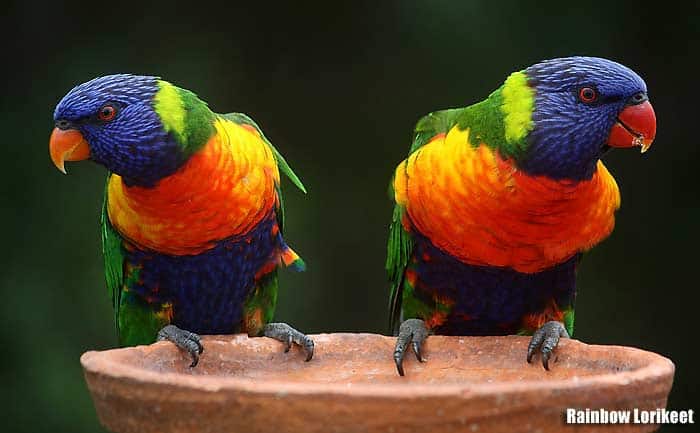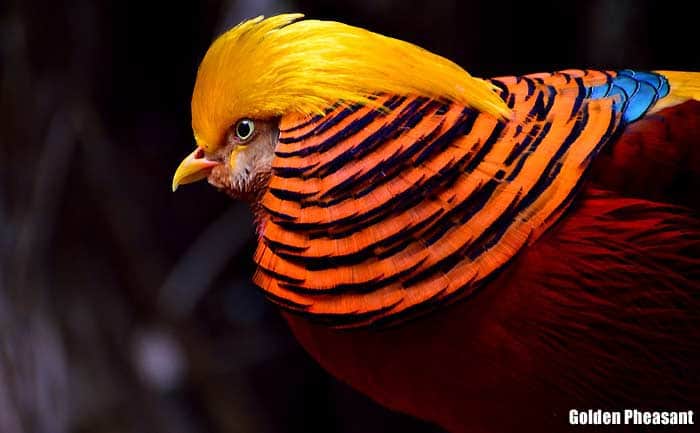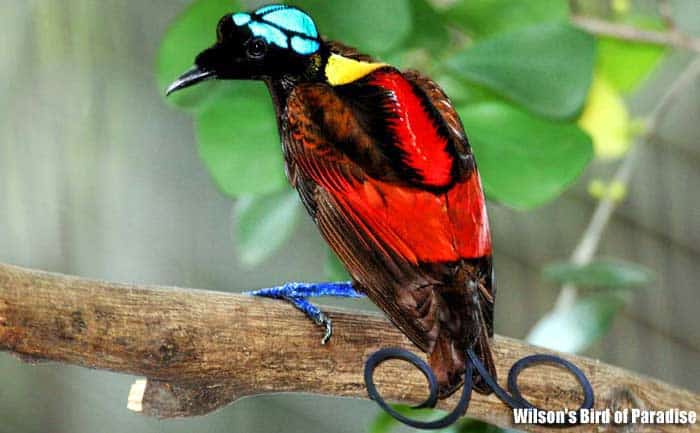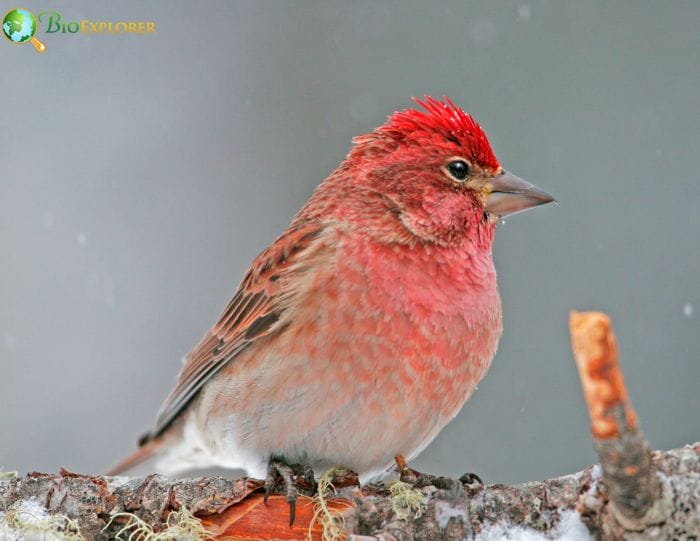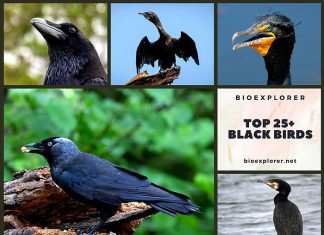Colorful birds: Among terrestrial animals, birds are probably the most colorful in terms of physical appearance. As expected, the spectacular display of various colors and patterns shown by different bird species is significant because birds themselves can recognize colors.
Table of Contents [show]
- Characteristics of Colors in Birds
- Colorful Feathers
- List of Colorful Birds
- 1. Red-necked Tanager
- 2. Mandarin Duck
- 3. Blue Crowned Pigeon
- 4. Blue/Azure Kingfisher
- 5. Paradise Tanager
- 6. Andean Cock-of-the-Rock
- 7. Purple Gallinule
- 8. Yellow-collared Lovebird
- 9. Northern Cardinal
- 10. Curl-crested Aracari
- 11. Spangled Cotinga
- 12. Toco Toucan
- 13. Gouldian Finch
- 14. Red-bearded Bee Eater
- 15. Lilac-breasted Roller
- 16. Crimson Rosella
- 17. Splendid Fairy Wren
- 18. Crowned Woodnymph
- 19. Painted Bunting
- 20. Indian Peafowl
- 21. Scarlet Macaw
- 22. The Resplendent Quetzal
- 23. Rainbow Lorikeet
- 24. Golden Pheasant
- 25. Scarlet-chested Parakeet
- 26. Wilson’s Bird-of-Paradise
- 27. Cassin’s Finch
- Black Birds
Characteristics of Colors in Birds
Regarding physical appearance, most bird exhibit sexual dimorphism, a trait wherein males are highly distinguishable from females. Males seem more colorful and dazzling than females for one apparent reason: to attract females during mating.
Colorful Feathers
Collectively speaking, bird feathers are referred to as the plumage. In particular, the plumage color in birds is formed in two different processes:
A) On one hand, colorful feathers are brought about by various pigments produced by birds. Such pigments are melanin, carotenoid, and porphyrin. The pigment melanin produces colors ranging from pale yellow to reddish-brown to dark black. The pigment carotenoid produces colors ranging from bright yellow to orangish-yellow. For instance, the pigments melanin and carotenoid interaction produce an olive-green color. Lastly, the pigment porphyrin produces various colors, such as brown, bright red, pink, and green.
B) On the other hand, bird feather colors are produced by the feathers’ structure. This means that instead of the pigments, colors are made when the feathers’ proteins refract the light. Three structural feathers exist, namely:
- Iridescent Feathers: Iridescent feathers can change their color at different viewing angles.
- Non-iridescent Feathers: Non-iridescent feathers can change from blue to brown depending on the light conditions.
- Ultraviolet Feathers: Ultraviolet feathers can reflect light found within the ultraviolet range.
Henceforth, listed below are the 27 most beautiful birds of the world in the Class Aves (birds) of the Animal Kingdom with Phylum as Chordata.
You can see the IUCN red list categories for each of these colorful birds listed below, which represents the vulnerability of the species at present. This ranges from Extinct to Least Concern.
List of Colorful Birds
Here we go! Welcome to the colorful birds world!
1. Red-necked Tanager
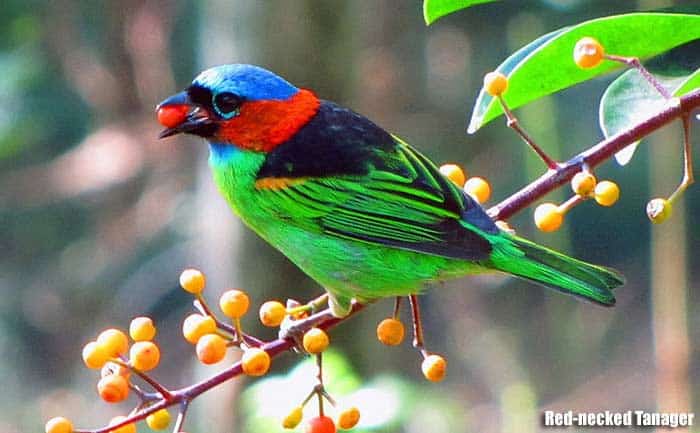
| Passeriformes | Thraupidae | Tangara | Tangara cyanocephala |
 Endemic to Eastern South America, the red-necked tanager appears to be very bright with its yellow-orange wings, bright red chin, deep blue crown and lower neck, and a brilliant green underneath.
Endemic to Eastern South America, the red-necked tanager appears to be very bright with its yellow-orange wings, bright red chin, deep blue crown and lower neck, and a brilliant green underneath.
- These colorful birds are known to reside in the canopy of forests and are characterized by their sharp “sip” sounding voices.
- Generally, the red-necked Tanager molts (sheds its feathers) once a year.

2. Mandarin Duck
| Anseriformes | Anatidae | Aix | Aix galericulata |
 Regarded as the world’s most beautiful duck, this native from China (hence the name) and Japan, this duck displays a wide array of colors such as blue, green, copper and silver.
Regarded as the world’s most beautiful duck, this native from China (hence the name) and Japan, this duck displays a wide array of colors such as blue, green, copper and silver.
- While both genders of the duck have a crest, this structure is more prominent in males, probably because this is mainly used to attract during mating.
- Also, males appear golden.

3. Blue Crowned Pigeon
| Columbiformes | Columbidae | Goura | Goura cristata |
 Also known as the Western crowned pigeon, the blue-crowned pigeon is characterized by having large blue crests in the head, and deep blue feathers around the eyes.
Also known as the Western crowned pigeon, the blue-crowned pigeon is characterized by having large blue crests in the head, and deep blue feathers around the eyes.
- Western crowned pigeons are very large pigeons and considered one of the “fairest” members of the Family Columbidae (Pigeons).
- Generally, like most birds in the animal kingdom, male blue-crowned pigeons are larger than their female counterparts.
- These colorful birds are native to Papua New Guinea and tend to be dispersed in the island’s rainforests.

4. Blue/Azure Kingfisher
| Coraciiformes | Alcedinidae | Ceyx | Ceyx azureus |
 Known to be great fish hunters from the riverside and sometimes above the water surface, blue kingfishers are small to medium size birds which have a very colorful appearance.
Known to be great fish hunters from the riverside and sometimes above the water surface, blue kingfishers are small to medium size birds which have a very colorful appearance.
- The feathers of kingfishers are mostly bright blue/azure (hence the name) in color.
- Unlike most birds, the feather color of kingfishers is caused by the feathers’ structure. Such causes the scattering of blue light, which is then reflected in our eyes, making them appear blue.
- The distribution pattern of kingfishers is cosmopolitan. Meaning they occur throughout the world, even in either temperate or tropical regions.

5. Paradise Tanager
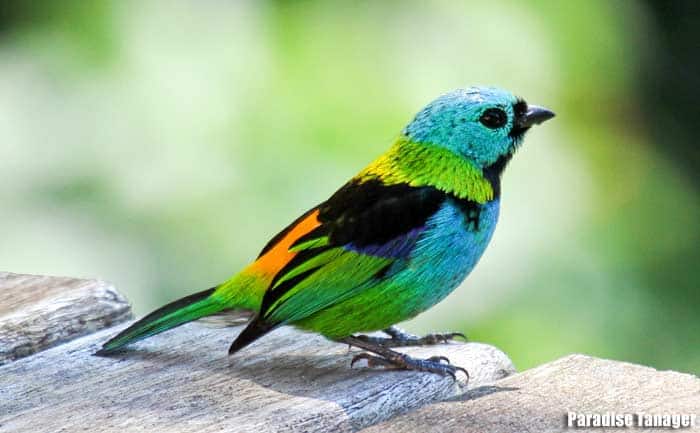
| Passeriformes | Thraupidae | Tangara | Tangara chilensis |
 Classy, neotropical, and colorful, the Paradise Tanager is living up to its name. This bird, widely distributed in the tropical forests of the Amazon in South America, is small yet very colorful with its bright apple green head, yellow or red rump (depending on species), and blue abdomen.
Classy, neotropical, and colorful, the Paradise Tanager is living up to its name. This bird, widely distributed in the tropical forests of the Amazon in South America, is small yet very colorful with its bright apple green head, yellow or red rump (depending on species), and blue abdomen.
- Aside from its appearance, the paradise tanager is a songbird, meaning it can make various musical sounds that are pleasant to the ears.
- One disclaimer though: this bird is not found in Chile, despite its species name T. chilensis.

6. Andean Cock-of-the-Rock
| Passeriformes | Cotingidae | Rupicola | Rupicola peruvianus |
 Considered the national bird of Peru, this small to medium-sized bird made it to the list of most colorful birds.
Considered the national bird of Peru, this small to medium-sized bird made it to the list of most colorful birds.
- Male Andean Cock-of-the-Rock birds are more colorful with their bright red head, breast, throat, and shoulders. They have grey wings, black underparts, and prominent disk crests over their bill.
- Conversely, the female birds are orange to brown and have smaller crests.
- This bird is usually found in warm regions, riverbanks, and forest streams.

7. Purple Gallinule
| Gruiformes | Rallidae | Porphyrio | Porphyrio martinicus |
 The Purple Gallinule is considered as one of the most beautiful birds primarily because of its plumage that displays a variety of colors.
The Purple Gallinule is considered as one of the most beautiful birds primarily because of its plumage that displays a variety of colors.
- Overall, this bird has a purple head, throat, and underparts, a greenback, a blue forehead, and a red beak with a yellow tip.
- Added to this uniqueness are its yellow legs.
- Interestingly, these colorful birds swim like ducks but can step on floating leaves like chickens.
- Basically, this species of bird is widely distributed in the humid and tropical regions of the United States.

8. Yellow-collared Lovebird
| Psittaciformes | Psittaculidae | Agapornis | Agapornis personatus |
 Also known as Masked lovebirds, yellow collared lovebirds are small colorful birds which are generally green in appearance (although upper parts are darker). In addition to that, they have black-colored heads and white eyerings, and very bright red beaks.
Also known as Masked lovebirds, yellow collared lovebirds are small colorful birds which are generally green in appearance (although upper parts are darker). In addition to that, they have black-colored heads and white eyerings, and very bright red beaks.
- As their name suggests, they have a yellow collar extending to the nape of the neck.
- Interestingly enough, the males and females of this species look identical in appearance.
- These colorful birds are endemic to Tanzania but were already brought to other countries like Kenya and Burundi.

9. Northern Cardinal
| Passeriformes | Cardinalidae | Cardinalis | Cardinalis cardinalis |
 Endemic to both North and South America, the Northern Cardinal bird is a songbird characterized by striking red and black face mask which extends up to the upper chest.
Endemic to both North and South America, the Northern Cardinal bird is a songbird characterized by striking red and black face mask which extends up to the upper chest.
- Females of this bird type are shown to be brown to grayish with some tints of red in their wings.
- Male Northern Cardinals have more defined face masks.
- At an early age, the colors of both males and females are identical to the adult females. But when fall comes, they shed their old feathers and grow new ones.
- The name of this bird (both scientific and common name) comes from the “cardinals” of the Roman Catholic Church, who usually wear red caps and robes.
What Do Cardinals Eat?

10. Curl-crested Aracari
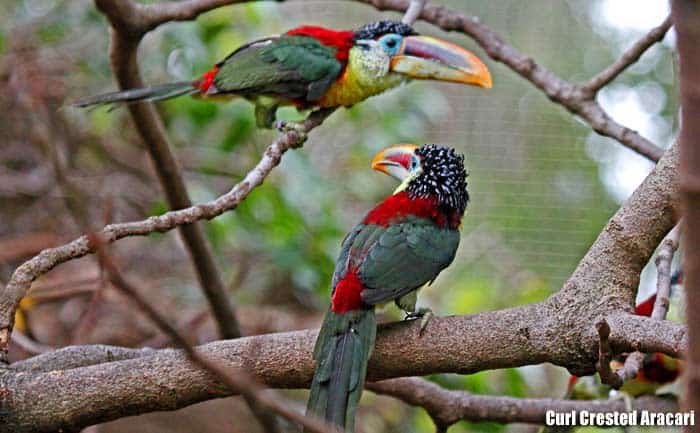
| Piciformes | Ramphastidae | Pteroglossus | Pteroglossus beauharnaesii |
 Coming from the Family Ramphastidae (Toucans), this bird is considered as one of the most colorful yet strangest looking bird in the world. This bird is characterized by having yellow underparts, a red back, dark green wings, and a very colorful beak.
Coming from the Family Ramphastidae (Toucans), this bird is considered as one of the most colorful yet strangest looking bird in the world. This bird is characterized by having yellow underparts, a red back, dark green wings, and a very colorful beak.
- This bird has unusual head feathers that can be likened to shiny black plastics.
- This bird is endemic only to the lowland forests of Western Brazil, Northern Bolivia, and Southern Amazon.

11. Spangled Cotinga
| Passeriformes | Cotingidae | Cotinga | Cotinga cayana |
 The Spangled Cotinga is a type of bird that frequently resides in the canopy of the Amazonian forests.
The Spangled Cotinga is a type of bird that frequently resides in the canopy of the Amazonian forests.
- Like any other bird species, male Spangled Cotingas are very brightly colored–they are turquoise in appearance with tints black in their back and wings, and a bright purple neck.
- Conversely, females are duller in color with an overall brown to grayish body and a prominent purple throat.
- Interestingly, the Spangled Cotinga bird lacks true vocalization. It can only emit a “whistling” sound as it flaps its wings when flying.

12. Toco Toucan
| Piciformes | Ramphastidae | Ramphastos | Ramphastos toco |
 Characterized by its very prominent multicolored beak, the Toco Toucan is the largest among all toucans. Aside from that, it is very recognizable due to its extremely black body, white throat, and blue eye rings.
Characterized by its very prominent multicolored beak, the Toco Toucan is the largest among all toucans. Aside from that, it is very recognizable due to its extremely black body, white throat, and blue eye rings.
- Aside from its physical appearance, the toucan bird makes an amazing creature because it can somehow regulate its overall body temperature by altering the blood flow in its beak.
- The Toco Toucan is endemic to South America and inhabits the savannas, tropical forests, and shrubland.

13. Gouldian Finch
| Passeriformes | Estrilididae | Erythrura | Erythrura gouldidae |
 Also known as the Rainbow finch, the Gouldian Finch is typically found in the savanna woodlands of Northern and Western Australia.
Also known as the Rainbow finch, the Gouldian Finch is typically found in the savanna woodlands of Northern and Western Australia.
- Like any bird, the male Gouldian Finch is extremely recognizable from its female counterpart. Males appear more brightly colored and have more intricate color marks and patterns.
- Both genders have green, black, yellow, and red markings. However, the males’ chests are purple, while the females are lilac.

14. Red-bearded Bee Eater
| Coraciiformes | Meropidae | Nyctyornis | Nyctyornis amictus |
 As its name suggests, the Red Bearded Bee Eater is a bee-eater type of bird that resides in the dense forests of the Indo-Malayan regions of South East Asia.
As its name suggests, the Red Bearded Bee Eater is a bee-eater type of bird that resides in the dense forests of the Indo-Malayan regions of South East Asia.
- This bird has an overall green color and a prominent red color in its face up to its throat (hence its name).
- In addition to that, they are characterized by having long tail feathers and curved brakes, and very pointed wings.

15. Lilac-breasted Roller
| Coraciiformes | Coraciidae | Coracias | Coracias caudatus |
 A member of the bird Family Coraciidae (Rollers), the Lilac-breasted Rollers are widely distributed in the Eastern and Southern Africa.
A member of the bird Family Coraciidae (Rollers), the Lilac-breasted Rollers are widely distributed in the Eastern and Southern Africa.
- Generally, this bird has a rich lilac color for its breast, pale green head, violet wings (shoulders, flight feathers, and rump), pale greenish blue coverts, blue underparts, brown back and scapulars, and black tail feathers.
- The lilac-breasted roller, like any other roller, is famous for its courtship flight.

16. Crimson Rosella
| Psittaciformes | Psittaculidae | Platycercus | Platycercus elegans |
 As its name suggests, the Crimson Rosella is highly characterized by its crimson body. Apart from that, the back and wing feathers are black but with some tints of red. Its flight feathers have alternate pale to dark blue patches.
As its name suggests, the Crimson Rosella is highly characterized by its crimson body. Apart from that, the back and wing feathers are black but with some tints of red. Its flight feathers have alternate pale to dark blue patches.
- Most Crimson Rosella reside in the wet forests of Northern Queensland and South Australia.

17. Splendid Fairy Wren
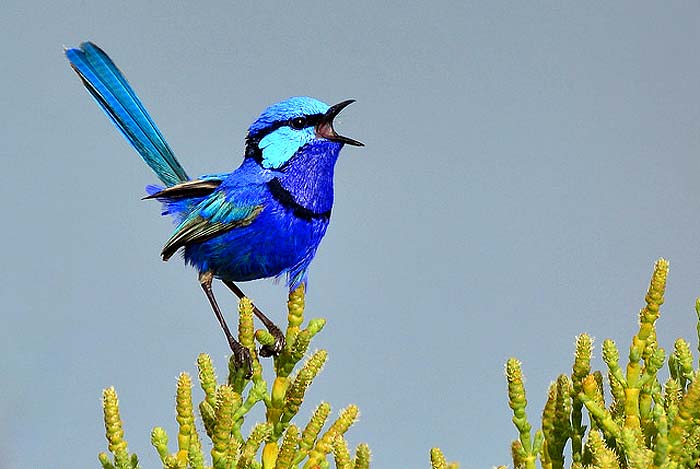
| Passeriformes | Maluridae | Malurus | Malurus splendens |
 The Splendid Fairy Wren is known to inhabit in the semi-arid to arid woodlands and shrublands of Australia.
The Splendid Fairy Wren is known to inhabit in the semi-arid to arid woodlands and shrublands of Australia.
- The feathers of the male Fairy-wren are dominantly blue (cobalt blue to violet-blue) in color. Its beak and legs are black and brown to gray, respectively.
- Conversely, the female Fairy-wren is paler with an overall brown color and white underparts. However, females have a distinguishable reddish tan line that extends from the beak up to the eyes.

18. Crowned Woodnymph
| Apodiformes | Trochilidae | Thalurania | Thalurania colombica |
 The Crowned wood nymphs are members of the genus Thalurania which is composed of hummingbirds. These types of hummingbirds generally reside in Eastern Panama up to Southern Ecuador.
The Crowned wood nymphs are members of the genus Thalurania which is composed of hummingbirds. These types of hummingbirds generally reside in Eastern Panama up to Southern Ecuador.
- As its name suggests, the violet-crowned woodnymph is the only one with a glittering green crown.
- Male Crowned Wood Nymphs are characterized by having green necks and blue breasts and abdomen.
- On the other hand, the female type of this bird is paler in color with a gray colored neck and a dark green to gray abdomen.

19. Painted Bunting
| Passeriformes | Cardinalidae | Passerina | Passerina ciris |
 The Painted Bunting bird is a member of the bird family Cardinalidae which is endemic to North America.
The Painted Bunting bird is a member of the bird family Cardinalidae which is endemic to North America.
- The male Painted Bunting has the French name, nonpareil, which means “without equal”, thus referring to its extremely fascinating appearance. The male plumage displays various colors, such as blue and green. Red and yellow.
- The female type of this bird is distinguishable due to its very prominent bright green color.

20. Indian Peafowl
| Galliformes | Phasianidae | Pavo | Pavo cristatus |
 As its name implies, the Indian peafowl can be found in India, Sri Lanka, in other countries of South Asia.
As its name implies, the Indian peafowl can be found in India, Sri Lanka, in other countries of South Asia.
- The Indian Peafowl is a member of the group called pheasants wherein the males are referred to as the peacocks whereas females are peahens. Collectively, they are called the peafowls.
- Like any other birds that display a sexually dimorphic trait, peacocks have a dazzling fan (up to 5 feet) of feathers of brilliant colors that grow from their back. Aside from that, males have a somewhat head crest and green throat feathers. As peacock feathers’ brilliant, shimmering patterns are iconic, some cultures treat them as sacred artifacts for prosperity.
- The vividly colored male peacock woos the female by spreading a spectacular fan of iridescent feathers with big glowing eyes. If the female is sufficiently impressed, she may allow him to mate.
- Conversely, peahens are duller in color, with only an overall brown body and white abdomen.

21. Scarlet Macaw
| Psittaciformes | Psittacidae | Ara | Ara macao |
 Macaws are considered as the largest species of colorful parrots in the world. For instance, scarlet macaws are widely distributed in the rainforests of Mexico, and Central and Southern America.
Macaws are considered as the largest species of colorful parrots in the world. For instance, scarlet macaws are widely distributed in the rainforests of Mexico, and Central and Southern America.
- Generally, the scarlet macaw, besides its overall red color, displays a wide mix of green, yellow, and blue feathers.
- Besides that, macaws are considered one of the most intelligent birds as they spend a lot of time using various tools and playing with objects.

22. The Resplendent Quetzal
| Trogoniformes | Trogonidae | Pharomachrus | Pharomachrus mocinno |
 A member of the Trojan bird family, this bird resides in the mountainous regions of Central America.
A member of the Trojan bird family, this bird resides in the mountainous regions of Central America.
- Interestingly enough, the iridescent color of this bird changes from green to blue depending on the time of the day.
- The Quetzal is known to inhabit the mountainous and tropical forests of Central America.

23. Rainbow Lorikeet
 Often seen in flocks, this bird is very distinguishable due to its feathers that range from green, blue, orange, and yellow.
Often seen in flocks, this bird is very distinguishable due to its feathers that range from green, blue, orange, and yellow.
- Aside from that, its most striking feature is its beak, which is bright red.
- Both sexes of this bird are identical in physical appearance.
- A lorikeet’s tongue has a brush-like tip for gathering nectar, fruits, and insects.
- Lorikeets are communal birds – they gather in the evening to spend the night.
- Basically, Rainbow Lorikeets are distributed in the coastal regions of Northern and Eastern Australia.

24. Golden Pheasant
| Psittacifornmes | Psittaculidae | Trichoglossus | Trichoglossus moluccanus |
 Also known as the Chinese Pheasant, the Golden Pheasant is a very timid bird that usually resides in the dark forests at day and only comes out during the night.
Also known as the Chinese Pheasant, the Golden Pheasant is a very timid bird that usually resides in the dark forests at day and only comes out during the night.
- Exhibiting sexually dimorphic traits, the male Golden Pheasants are distinguishable because of their golden crest. Aside from that, it has a bright red abdomen, dark-colored wings, and a long patterned brown tail.
- On the other hand, the female Golden Pheasant is less colorful in appearance, with an overall brown body and pale yellow legs. The female bird is also thinner and more slender.
- As its name suggests, the Golden Pheasant can be found in the forests of central and western parts of China.

25. Scarlet-chested Parakeet
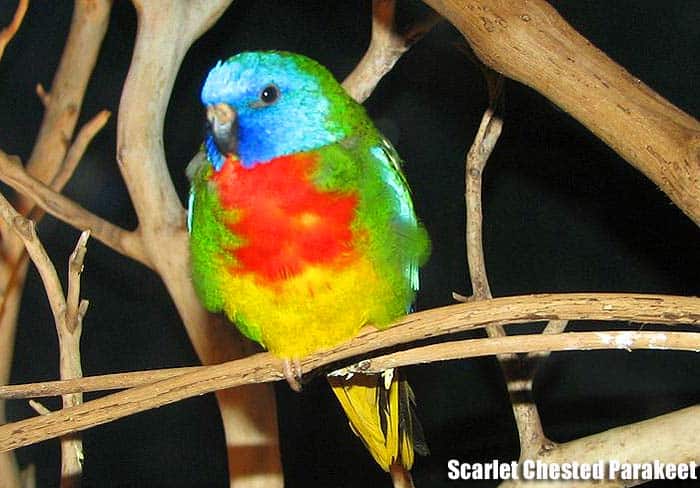
| Psittaciformes | Psittaculidae | Neophema | Neophema splendida |
 Our next colorful bird is the beautiful Scarlet-chested parrot (aka scarlet-breasted parrot). These colorful birds are endemic to Southern Central Australia and some Southern Western Australia.
Our next colorful bird is the beautiful Scarlet-chested parrot (aka scarlet-breasted parrot). These colorful birds are endemic to Southern Central Australia and some Southern Western Australia.
- Appearance-wise, these birds have two forms (i.e., sexually dimorphic). The bright blue-faced with a scarlet chest and yellowish lower part among the green plumage is the male, whereas the female is almost the same except missing the red color in the chest.
- Diet-wise, these colorful birds feed on grass seeds. These parakeets can last long without water as they eat succulent plants that help them keep hydrated.
- The binomial name for the scarlet-chested parrot is Neophema splendida, which was named by the famous ornithologist John Gould in 1841.
- The Breeding season for these parrots is from August to October.

26. Wilson’s Bird-of-Paradise
| Passeriformes | Paradisaeidae | Cicinnurus | Cicinnurus respublica |
 Last but not the least is the Bird-of-Paradise, which is not to be confused with the Birds of Paradise plant. Most Bird-of-Paradise birds are distributed in Papua New Guinea, Australia, and Eastern Indonesia.
Last but not the least is the Bird-of-Paradise, which is not to be confused with the Birds of Paradise plant. Most Bird-of-Paradise birds are distributed in Papua New Guinea, Australia, and Eastern Indonesia.
- The male type of this bird is shown to exhibit a wide variety of colors: a prominent turquoise crown, yellow cape, red back, and green breast and tail feathers.
- Interestingly, though, the crowns of the males are not feathers but bare skin. Criss-crossed by black lines of feathers.
- Females are duller in appearance with a lilac-blue head, reddish upper body, and brown wings. Also, females lack tail feathers.

27. Cassin’s Finch
| Animalia | Aves | Passeriformes | Fringillidae | Chordata | Haemorhous cassinii |
 The Cassin’s Finch stands out as one of the most vividly colored finches inhabiting the coniferous forests of western North America.
The Cassin’s Finch stands out as one of the most vividly colored finches inhabiting the coniferous forests of western North America.
- Adult male Cassin’s Finches display uniquely bright plumage, with rosy pink bodies that contrast sharply against dull brown streaking on their flanks and breast. Their crowns and rumps are colored a rich reddish-orange, unlike any other finch in their range.
- When perched among pine branches, the males’ brightly hued bodies appear to glow against the green needles. Their boldly peaked heads and sharply etched wing patterns add to the Cassin’s visual allure.
- Females are more demure, yet still elegant, with delicately streaked gray-brown plumage that provides camouflage while nesting. Though small, the Cassin’s Finch punches above its weight with a remarkable intensity of color and artful plumage well-adapted to life amidst western mountain habitats.
The Cassin’s vivid aesthetic stands out both in the field and in contrast to their more modestly dressed finch relatives.

While these colorful birds are spectacular, some of them are becoming endangered even in their native habitats. Due to their colorful and unique plumage, they have become a target for many hunters in the forest. Another major threat to these birds is the loss of habitats due to the deforestation and the environment in general.
Suggested Reading:
Black Birds
Cite This Page
Viewed using Just Read
